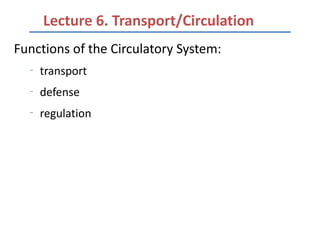
Lecture 6 transport circulation_part 1
- 1. Lecture 6. Transport/Circulation Functions of the Circulatory System: – transport – defense – regulation
- 2. Animals without Circulatory System protozoans sponges flatworms cnidarians
- 3. • a single-celled protist living in water has a sufficient surface area of plasma membrane to service its entire volume • the gastrovascular cavity of hydra opens to the exterior, both outer and inner layers of cells are bathed in water
- 4. • in cnidarians like Aurelia, the products of digestion in the gastrovascular cavity are directly available to the cells of the inner layer • only a short distance to diffuse to the cells of the outer layer
- 5. • flat body = way to maximize exposure to the surrounding medium
- 6. – most organisms have extensively folded or branched internal surfaces specialized for exchange with the environment – the circulatory system shuttles material among all the exchange surfaces within the animal
- 7. Internal Fluid Environment • cellular cytoplasm in unicellular animals protozoans
- 8. Internal Fluid Environment • multicellular animals
- 9. Two Types of Circulatory System • Two types of circulatory systems • Closed – heart pumps blood in a network of blood vessels and capillaries • Open – heart pumps haemolymph into tissue spaces
- 10. Two Types of Circulatory System insects, other arthropods, earthworms, squids, most mollusks octopuses, vertebrates
- 11. Plan and Parts of Vertebrate Circulatory System • often called the cardiovascular system • the heart consists of one atrium or two atria, and one or two ventricles • arteries, arterioles, veins, venules, and capillaries • blood
- 12. Plan and Parts of Vertebrate Circulatory System • The Vertebrate Circulatory System • Closed type • Heart : • Atrium – receive blood from circulation • Ventricle – pumps blood to blood vessels
- 13. Plan and Parts of Vertebrate Circulatory System • The Vertebrate Circulatory System • Blood vessels : • Artery – brings blood AWAY from the heart • Arteriole – leads to capillaries • Capillary – where gas exchange takes place • Venule – leads to vein • Vein – brings blood TO the heart
- 15. – two-chambered heart – subsidiary chambers: CA sinus venosus (SV), Artery conus arteriosus (CA) SV – blood circuit: single circuit
- 16. – three-chambered heart – blood circuit: double circuit Vein Artery
- 17. Heart of an Amphibian with Lungs Fig. 31.11
- 18. • Reptiles also have double circulation with pulmonary (lung) and systemic circuits • reptilian heart is three- chambered (except for crocodiles) • ventricle is partially divided
- 19. – four-chambered heart – crocodilians, birds, and mammals – blood circuit: double circuit Vein Artery
- 20. Human Heart (Bicuspid or mitral valve) (Tricuspid valve)
- 21. Coronary System
- 23. The Cardiac Cycle Systole - contraction Diastole - relaxation
- 25. • cardiac output (5.25 L/min) depends on two factors: – the rate of contraction or heart rate (number of beats per second) – stroke volume (75 mL), the amount of blood pumped by the left ventricle in each contraction
- 26. • the heart sounds we can hear with a stethoscope are caused by the closing of the valves – sound pattern is “lub-dup, lub-dup, lub-dup” – “lub” is created by the recoil of blood against the closed AV valves – “dup” is the recoil of blood against the semilunar valves
- 27. • the impulses generated during the heart cycle produce electrical currents that are conducted through body fluids to the skin • the currents can be detected by electrodes and recorded as an electrocardiogram (ECG or EKG).
- 28. The control of heart rhythm
- 29. Fig. 31.14
- 30. – two sets of nerves (sympathetic and parasympathetic) affect heart rate with one set speeding up the pacemaker and the other set slowing it down – the pacemaker is also influenced by hormones – rate of impulse generation by the pacemaker increases in response to increases in body temperature and with exercise
- 32. 32 Blood flow in veins
- 33. The interrelationship of cross- sectional area of blood vessels, blood flow velocity, and blood pressure.
- 34. Measurement of blood pressure Makes use of a sphygmomanometer and the brachial artery • Systolic pressure - peak pressure in the arteries, which occurs near the end • of the cardiac cycle when the ventricles are contracting Dyastolic pressure - minimum pressure in the arteries, which occurs near the • beginning of the cardiac cycle when the ventricles are filled with blood
- 35. Changes in blood pressure Varies within the day due to circadian rhythm • Also change due to stress, nutrition, exercise, • drugs, disease, and simply standing up Hypertension – when arterial pressure is abnormally • high Hypotension – when arterial pressure is abnormally low •
- 36. Blood flow in capillary beds
- 37. Fluid exchange between capillaries and the interstitial fluid
- 38. The Blood
- 40. • Hemophilia – inability to clot blood – a sex-linked trait • Hemophilia A – clotting factor VIII deficiency • Hemophilia B – clotting factor IX deficiency
